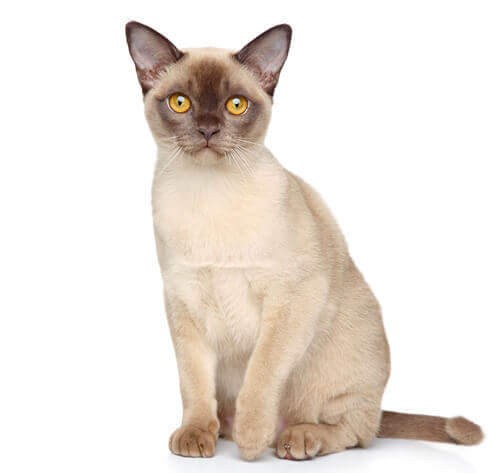
An extremely people-oriented breed, the Burmese is frisky and mischievous well into adulthood. Craving close contact, she loves to cuddle in warm laps. With an almost doglike personality, the Burmese can be taught to retrieve. This breed is good with children and tolerates cat friendly dogs. Having a short, satinlike coat and compact body, this cat has large, expressive eyes that are one of the breed’s endearing traits.
DID YOU KNOW? The Burmese originated from cats that came from the Malay Peninsula of Southeast Asia, where these highly prized felines were the personal pets of the head priest. Referred to as “Rajah” cats, they were loved and honored by old Burmese kings.
The need-to-know
- Highly active and inquisitive cat
- Sociable and dependent cat
- Very talkative cat
- Lean and elegant cat breed
- Requires grooming once a week
- Outdoor cat
- Great family cat
Personality

The Burmese cat is an extremely friendly and affectionate creature that needs attention from human beings to be happy. The Burmese cat breed is very demanding and Burmese cats will follow owners around the house crying for attention – they might even climb their owner's leg begging to be picked up and cuddled! As very vocal cats they will often greet owners when they return home or demand what they want and to join in with all activities. Loyal to their owners, they are sometimes known as the 'dog cat' as many are happy to play retrieve. They are very intelligent and can work out problems such as opening doors are often successful escape artists!
History and Origins

Country of Origin: Burma
A dark brown cat, resembling a Siamese cat in shape, was first taken from the far east to California in the 1930s. As there were no other Burmese cats in America at the time, the 'Wong Mau' breed was mated with a Seal Point Siamese cat. Through selective breeding a new dark coated breed became known as the Burmese cat we know today. The Burmese cat was first recognised as a breed in American and came to Europe in the 1940s. Breeding programmes have since developed a range of coat colours.
Nutrition and Feeding

Every cat is unique and each has their own particular likes, dislikes, and needs when it comes to food. However, cats are carnivores and every cat must obtain 41 different and specific nutrients from their food. The proportion of these nutrients will vary depending on age, lifestyle and overall health, so it's not surprising that a growing, energetic kitten needs a different balance of nutrients in her diet than a less active senior cat. Other considerations to bear in mind are feeding the right quantity of food to maintain 'ideal body condition' in accordance with feeding guidelines and catering to individual preference regarding wet or dry food recipes.
Other Information

Health and common issues
Burmese cats are quite robust healthwise but some lines of the breed do seem to be susceptible to diabetes mellitus. Hypokalaemic polymyopathy (muscle weakness due to low levels of blood potassium) is seen occasionally in young Burmese cats. A few Burmese cats have developed an unusual condition called feline orofacial pain syndrome. This condition causes exaggerated licking and chewing movements, and pawing at the mouth, which can be very distressing for the cat. In the USA there has been a problem with a head and brain deformity but is not reported in the UK. Some lines of Burmese cat breeds also have unusual eating habits and will eat wool garments and other inedible items (this is known as pica).
Best cat breeds for children
While this breed tends to be excellent with kids, each cat has a different personality based on training and life experience. Please consult the adoption organisation, if you are adopting, for details on a specific cats character.